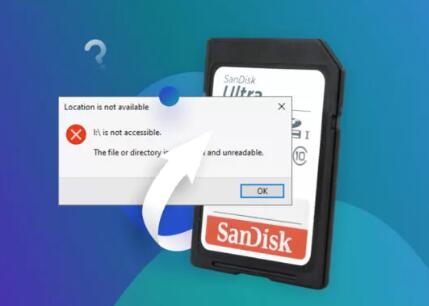Mini SD cards are widely used for storing data in devices like smartphones, cameras, and tablets. However, they can sometimes become corrupted due to various reasons such as improper removal, virus infections, file system errors, or physical damage. When a mini SD card gets corrupted, it may become unreadable, prevent data access, or display error messages.
Common Causes of Mini SD Card Corruption
Understanding the reasons behind mini SD card corruption can help prevent future issues. Some of the common causes include:

Improper Ejection: Removing the card without safely ejecting it from a device.
File System Errors: Occurs due to sudden power loss or software malfunctions.
Virus and Malware Attacks: Infected files can damage the file system.
Physical Damage: Exposure to water, heat, or bending can cause permanent damage.
Bad Sectors: Storage blocks that have become unreadable over time.
Exceeding Write Cycles: Flash storage has a limited number of write/erase cycles before failure.
Methods to Fix a Corrupted Mini SD Card
1. Try a Different Device or Card Reader
Before attempting any advanced fixes, insert the mini SD card into another device or card reader. Sometimes, the issue may be with the reader rather than the card itself.
2. Restart Your Device
If your device fails to recognize the mini SD card, a simple restart can sometimes resolve the issue by refreshing system settings.
3. Check for Connection Issues
Inspect the card slot for dust or debris and clean it using a soft cloth or compressed air.
Ensure the mini SD card is properly inserted into the adapter or device.
4. Assign a New Drive Letter (Windows)
If your computer recognizes the card but doesn’t show it in File Explorer, assigning a new drive letter may help.
Press Win + X and select Disk Management.
Locate your mini SD card and right-click on it.
Choose Change Drive Letter and Paths….
Click Add, assign a new letter, and click OK.
5. Run Windows Error Checking Tool
Open File Explorer and locate the SD card.
Right-click and choose Properties.
Navigate to the Tools tab and click Check under Error checking.
Follow the prompts to fix detected errors.
6. Use CHKDSK Command (Windows)
CHKDSK (Check Disk) is a built-in utility to scan and repair file system errors.
Connect the mini SD card to a Windows PC.
Press Win + X and select Command Prompt (Admin).
Type chkdsk X: /f /r (replace X with your SD card’s drive letter).
Press Enter and wait for the process to complete.
7. Use Disk Utility (Mac)
For macOS users, Disk Utility can help repair a corrupted mini SD card.
Insert the SD card and open Disk Utility (Command + Space, type Disk Utility, and hit Enter).
Select the SD card from the left panel.
Click First Aid and let the tool scan and repair the card.
8. Format the Mini SD Card (Last Resort)
If all else fails, formatting the card can restore functionality, though it will erase all data.
Windows Formatting Steps:
Open File Explorer and locate the SD card.
Right-click and choose Format.
Select FAT32 or exFAT as the file system.
Click Start to begin formatting.
Mac Formatting Steps:
Open Disk Utility.
Select the SD card and click Erase.
Choose MS-DOS (FAT) or exFAT.
Click Erase to format the card.
Using Command Prompt (Windows):
Open Command Prompt as administrator.
Type diskpart and press Enter.
Type list disk and press Enter.
Identify your SD card and type select disk X (replace X with the correct disk number).
Type clean, then create partition primary, and finally format fs=fat32.
9. Use Data Recovery Software
Panda Assistant is a powerful data recovery software that can help fix a corrupted Mini SD card, making it possible to recover lost or inaccessible files. If your Mini SD card becomes corrupted, it may not be recognized by your device, or it might display error messages when you try to access the data. Panda Assistant can assist you by scanning the card, locating lost files, and repairing damaged sectors.
Scan the Mini SD Card: Start by launching Panda Assistant. Insert the corrupted Mini SD card into your computer using a card reader. Select the SD card from the list of available drives and click the “Scan” button. Panda Assistant will begin a deep scan of the card to locate any recoverable data.
Recover Files: Once the scan is complete, Panda Assistant will display a list of recoverable files. You can preview the files to ensure they are intact before proceeding. Select the files you want to recover and choose a safe location on your computer to save them.
Fix Corruption Issues: After recovering your files, Panda Assistant can attempt to repair the corrupted Mini SD card. The software will analyze the file system and attempt to repair any damaged or lost sectors, making the card functional again.
Format the Card: In cases where the Mini SD card remains unresponsive, Panda Assistant may suggest formatting the card. While this will erase all existing data, it can resolve issues related to corruption and restore the card to its original condition. After formatting, you can reinsert the card and restore your recovered files.
About us and this blog
Panda Assistant is built on the latest data recovery algorithms, ensuring that no file is too damaged, too lost, or too corrupted to be recovered.
Request a free quote
We believe that data recovery shouldn’t be a daunting task. That’s why we’ve designed Panda Assistant to be as easy to use as it is powerful. With a few clicks, you can initiate a scan, preview recoverable files, and restore your data all within a matter of minutes.
Subscribe to our newsletter!
More from our blog
See all postsRecent Posts
- Data recovery salt lake city utah 2025-04-18
- Data recovery sacramento 2025-04-18
- Data recovery miami 2025-04-18

 Try lt Free
Try lt Free Recovery success rate of up to
Recovery success rate of up to









